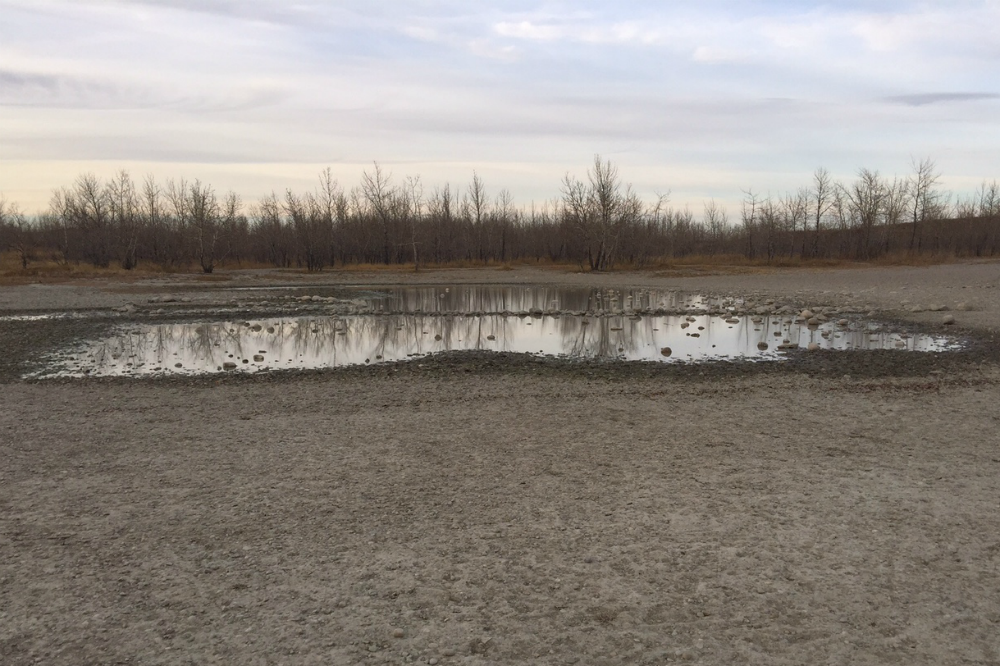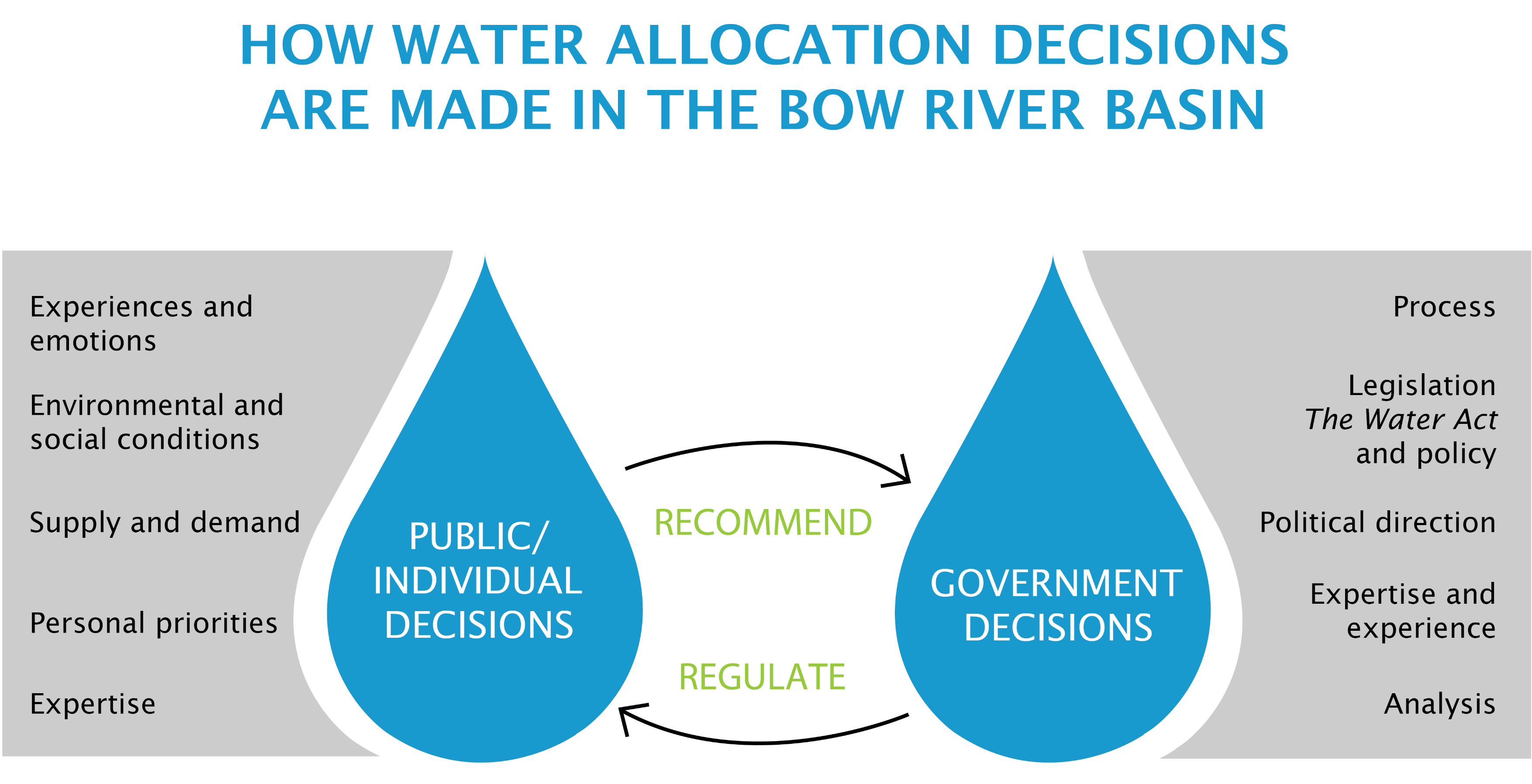Water management decisions in the Bow River basin
The challenge of managing water in the Bow River basin
As communities, the agricultural sector, energy industry, and land uses continue to grow; water is required for the growth and prosperity of these sectors. Thus, future water management across each of these interconnected users will be a delicate balance.
In the Bow River basin, water resources are allocated according to Alberta’s Water Act. The Water Act, is administered by Alberta Environment and Parks (AEP), except for oil, gas, and coal applications and licenses which are administered by the Alberta Energy Regulator (AER). The Water Act allows water users such as municipalities, large and small businesses, and individuals, to apply for water allocations (an amount of water) or transfers to meet their water needs. Before a water licence is issued to a user, AEP or AER will consider the following:
- Water source
- Location of the diversion site
- Volume, rate, and timing of the water to be diverted
- Priority of the water right established by the licence
- Purpose (specified use) of the water
- Natural water supply
- Existing licences, and
- Apportionment agreements.
Alberta’s current water allocation system provides water for users who hold licences. In times of water shortages, those who hold senior water licences are entitled to use their allocation of water before junior licence holders.
Learn more about the governance of water licences, transfers, and allocations.

In addition to The Water Act, the Water for Life Strategy is a policy document developed by the Government of Alberta to help manage Alberta’s water resources, including those of the Bow River basin. The strategy, first implemented in 2003, has helped guide Alberta’s water management with three main goals:
- Safe, secure drinking water
- Healthy aquatic ecosystems, and
- Reliable, quality water supplies for a sustainable economy.
Alberta’s Water for Life Strategy commits to wise water management practices that ensure the longevity of the resource for future generations.
In the Bow River basin, water management is critical due to competing uses of the resource in the basin. While this basin covers a smaller area compared to other basins in Alberta, it includes emerging energy development, growing municipalities, and agricultural needs which impact water use and demand. To address competing water needs, the Approved Water Management Plan for the South Saskatchewan River Basin (SSRB) was launched in 2006 to guide a new era of water management across the SSRB (including the Bow River sub-basin).
As part of this plan AEP formally closed parts of the SSRB, including the Bow River basin, to new surface water allocations, particularly in response to increased water demands from agricultural, municipal, and industrial users. This action was also implemented to restore and protect instream flow needs. In addition to this closure, AEP recommended the following actions:
- Coordinate water management throughout the SSRB;
- The establishment of Water Conservation Objectives (WCOs), where the flow of water should be 45% of the natural rate of flow, or the existing instream objective plus 10%, whichever is greater at any point in time;
- The Director is authorized to consider applications for transfers of water allocations;
- The Director is authorized to withhold up to 10% of the volume of water being transferred, if it is shown that this action is in the public’s best interest, and;
- Three broad avenues can be explored by AEP in the SSRB, including:
- Continued improvements to water management and allocation administration
- The development of water markets and transfers, and
- Improvement to water conservation.
Together, The Water Act, Water for Life Strategy, and Approved Water Management Plan for the SSRB provide a foundation and framework for water management in the Bow River basin. Furthermore, these rules and regulations provide direction when addressing the management of energy, agricultural, and municipal development occurring in the Bow River basin.
How are decisions made in the Bow River Basin?
Alberta’s Water for Life Strategy supports a system of shared responsibility for water management, in which government engages the public and individuals living in each basin to provide input based on their interests and expertise. Due to the differences between Alberta’s seven major basins, this approach also intends to identify the unique challenges and opportunities with water supply, use, and quality that face each basin. It is important to note that the public decides on recommendations based on their perspective and circumstances. These recommendations are provided to government, who determines the impact of the recommendations on the application of regulations and policy. Thus, decision-making occurs at all levels.

In addition to individuals, there are organizations that operate in the basin and also provide recommendations to government. For example, under the Water for Life Strategy, Watershed Planning and Advisory Councils (WPACs) are recognized as representing local interests and expertise within each basin. WPAC’s are multi-stakeholder, non-profit organizations that help the provincial government by assessing the state of their watershed through regular reporting and activities . WPACs also work with government to provide collaborative activities such as; public consultation, advisory groups, and collaborative alliances, as well as community and individual stewardship.
In the Bow River basin, the Bow River Basin Council (BRBC) is the active WPAC and advisory body to the Minister of Environment and Parks. The open general membership of the BRBC elects representatives to the Board of Directors, which in turn, oversees the activities of the Executive Director and staff. Thus, the BRBC is an inclusive, cooperative, and collaborative organization that aims to engage all stakeholders within the basin to advance the health of the watershed . When specific actions are recommended to AEP, the BRBC Board of Directors will approve each recommendation prior to it being sent to AEP. The primary goal of the BRBC is to help the basin achieve high water standards that enable the basin to be a national leader in water management.

The BRBC works closely with the Government of Alberta to promote a healthy watershed, address the various competing demands on water in the basin, and provide this information to the public. While the BRBC does not have final decision-making power, they provide recommendations to the Government of Alberta that are considered by the Director* which could be included in regional plans such as the SSRB (by amendments).
Overall, several policies, frameworks, and strategies have been developed to manage Alberta’s water resources. However, with increasing competition for water from industrial, agricultural, and municipal users, decision-makers will need to manage significant trade-offs between competing sectors following existing Acts and Plans. Consequently, decision-makers in the Bow River basin could significantly benefit from a decision support tool to understand the application of the Nexus concept throughout the basin. Furthermore, this would inform policy decisions related to trade-offs for the most beneficial use of the basin’s water resources on a yearly basis.
What other public policies manage the Nexus concept?
In addition to the above mentioned policy initiatives, numerous other policies influence management of the Nexus concept in the Bow River basin, including Alberta’s Integrated Resource Management System, the South Saskatchewan Regional Plan (SSRP), and Cumulative Effects Management.
Alberta’s Integrated Resource Management System manages the cumulative effects of Alberta’s energy, mineral, forest, agriculture, land, air, water, and biodiversity resources . This approach mimics the broader Nexus concept in that it provides clear objectives to operators in the basin, aligns natural resources with environmental policies, and uses environmental, social, and economic data to inform decision-making.
The South Saskatchewan Regional Plan (SSRP) is another integral policy that informs ongoing activities in the Bow River basin. This Plan was first implemented in September 2014 and resides under Alberta’s Land-Use Framework – the policy that administers the regional planning process in the province. The SSRP provides a long-term vision for sub-basins including the Bow River basin to balance environmental, social and economic goals. The Plan also clearly identifies Alberta’s long term commitment to conservation, protection of watersheds, sustaining biodiversity and sensitive habitats, and to the continued growth and prosperity of southern Alberta .
Finally, Cumulative Effects Management (CEM) is another policy related to the collective management of Alberta’s resources that focuses on the achievement of outcomes. This policy also considers the impacts of multiple development pressures, risk assessments, collaborative work, and the integration of environmental, social and economic considerations . CEM is mainly used in the development of regional plans throughout Alberta, including the Bow River basin.
* For the purposes of the Alberta Water Nexus Project pilot, the ultimate decision-maker is the designated Water Director at Alberta Environment and Parks (AEP), since this person issues approvals and/or licences under Alberta’s Environmental Protection and Enhancement Act and Water Act . However, the general public and numerous other actors in the basin, such as municipalities, businesses, and watershed groups such as the Bow River Basin Council (BRBC), help inform and recommend actions that impact the Director’s decisions. As a result, we use the term ‘decision-makers’ to capture all actors who contribute to decisions that affect the basin’s water resources.
Sources
[1] “Water Management in Alberta.” Alberta Environment and Parks. Accessed October 2015. http://www.waterforlife.alberta.ca/02808.html
[2] “Highlights of the Approved Water Management Plan for the SSRB.” Alberta Environment and Parks. Accessed October 2015. http://aep.alberta.ca/water/programs-and-services/river-management-frameworks/south-saskatchewan-river-basin-approved-water-management-plan/documents/SSRB-HighlightsApprovedPlan-2006.pdf
[3] “Alberta Watershed Planning and Advisory Councils.” Alberta WPACs. Accessed November 2015. http://www.albertawpacs.ca/
[4] “Bow River Basin Council: Mission and Purpose.” BRBC website. Accessed November 2015. http://brbc.ab.ca/index.php/about-us/about-the-brbc
[5] “Integrated Resource Management System.” Government of Alberta. Accessed November 2015. http://www.oilsands.alberta.ca/FactSheets/Integrated_Resource_Management.pdf
[6] “South Saskatchewan Region” Alberta Environment and Parks. Accessed November 2015. https://landuse.alberta.ca/REGIONALPLANS/SOUTHSASKATCHEWANREGION/Pages/default.aspx
[7] “Cumulative Effects Management.” Alberta Environment and Parks. Accessed November 2015. https://landuse.alberta.ca/CumulativeEffects/CumulativeEffectsManagement/Pages/default.aspx
[8] “Fact Sheet: Water Rights and Property Rights.” Environmental Law Centre. Accessed December 4, 2015. http://www.elc.ab.ca/Content_Files/Files/Water_Rights.pdf
